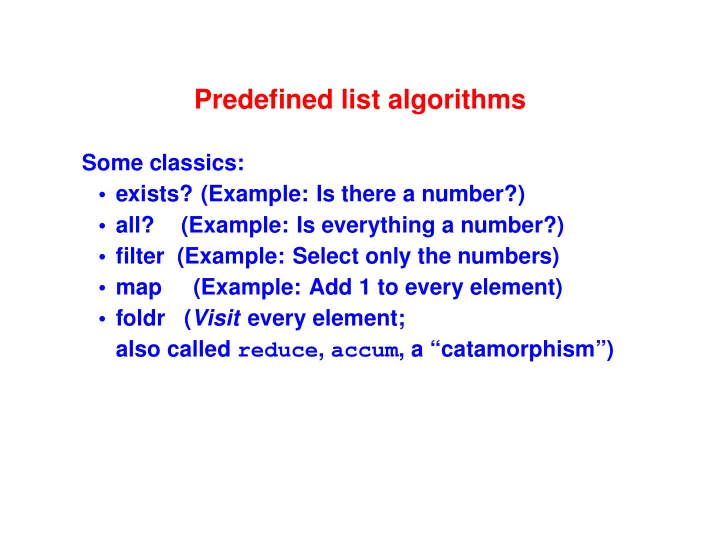

Predefined list algorithms Some classics: • exists? (Example: Is there a number?) • all? (Example: Is everything a number?) • filter (Example: Select only the numbers) • map (Example: Add 1 to every element) • foldr ( Visit every element; also called reduce , accum , a “catamorphism”)
The power of lambda Using first-class functions to enlarge your vocabulary • List computations • Cheap functions from other functions Supported in many languages: Haskell, ML, Python, JavaScript
Defining exists? ; (exists? p? ’()) = #f ; (exists? p? (cons y ys)) = #t, if (p? y) ; (exists? p? (cons y ys)) = (exists? p? ys), otherwise -> (define exists? (p? xs) (if (null? xs) #f (if (p? (car xs)) #t (exists? p? (cdr xs))))) -> (exists? number? ’(1 2 zoo)) #t -> (exists? number? ’(apple orange)) #f
Defining filter ; (filter p? ’()) == ’() ; (filter p? (cons y ys)) == ; (cons y (filter p? ys)), when (p? y) ; (filter p? (cons y ys)) == ; (filter p? ys), when (not (p? y)) -> (define filter (p? xs) (if (null? xs) ’() (if (p? (car xs)) (cons (car xs) (filter p? (cdr xs))) (filter p? (cdr xs)))))
Running filter -> (filter (lambda (n) (> n 0)) ’(1 2 -3 -4 5 6)) (1 2 5 6) -> (filter (lambda (n) (<= n 0)) ’(1 2 -3 -4 5 6)) (-3 -4)
Defining and running map -> (define map (f xs) (if (null? xs) ’() (cons (f (car xs)) (map f (cdr xs))))) -> (map number? ’(3 a b (5 6))) (#t #f #f #f) -> (map (lambda(x)(* x x)) ’(5 6 7)) (25 36 49)
Foldr
Algebraic laws for foldr Idea: � 0 + 0 : x 1 + x n � + : + � � � (foldr (plus zero ’())) = zero (foldr (plus zero (cons y ys))) = (plus y (foldr plus zero ys)) Note: Binary operator + associates to the right. Note: zero might be identity of plus .
Code for foldr Idea: � 0 + 0 : x 1 + x n � + : + � � � -> (define foldr (plus zero xs) (if (null? xs) zero (plus (car xs) (foldr plus zero (cdr xs))))) -> (val sum (lambda (xs) (foldr + 0 xs))) -> (sum ’(1 2 3 4)) 10 -> (val prod (lambda (xs) (foldr * 1 xs))) -> (prod ’(1 2 3 4)) 24
Another view of operator folding ’(1 2 3 4) (cons 1 (cons 2 (cons 3 (cons 4 ’())))) = (foldr + 0 ’(1 2 3 4)) (+ 1 (+ 2 (+ 3 (+ 4 0 )))) = (foldr f z ’(1 2 3 4)) (f 1 (f 2 (f 3 (f 4 z )))) =
Why the redundancy? 1. Functions like exists? , map , filter are subsumed by 2. Function foldr , which is subsumed by 3. Recursive functions Answer: Redundancy supports specificity, which makes code eaiser to reason about.
Currying: The motivation Remember me? q-with-y? = (lambda (z) (q? y z)) Happens so often, there is a function for it: q-with-y? = ((curry q?) y) Called a partial application (one now, one later)
Map/search/filter love curried functions -> (map ((curry +) 3) ’(1 2 3 4 5)) ; add 3 to each element -> (exists? ((curry =) 3) ’(1 2 3 4 5)) ; is there an element equal to 3? -> (filter ((curry >) 3) ’(1 2 3 4 5)) ; keep elements that 3 is greater then
The idea of currying • Input: a binary function f(x,y) • Output: a function f' – Input: argument x – Output: a function f'' * Input: argument y * Output: f(x,y) What is the benefit? • Functions like exists? , all? , map , and filter expect a function of one argument. To get there, we use currying and partial application. Slogan: Curried functions take their arguments “one-at-a-time.”
What’s the algebraic law for curry ? ... (curry f) ... = ... f ... Keep in mind: All you can do with a function is apply it! (((curry f) x) y) = (f x y) Three applications: so implementation will have three lambda s
From law to code ;; curry : binary function -> value -> function ;; (((curry f) x) y) = (f x y) -> (val curry (lambda (f) (lambda (x) (lambda (y) (f x y))))) -> (val positive? ((curry <) 0))
Composing Functions In math, what is the following equal to? (f o g)(x) == ??? Another algebraic law, another function: (f o g) (x) = f(g(x)) (f o g) = lambda x. (f (g (x)))
One-argument functions compose -> (define o (f g) (lambda (x) (f (g x)))) -> (define even? (n) (= 0 (mod n 2))) -> (val odd? (o not even?)) -> (odd? 3) #t -> (odd? 4) #f
Proofs about functions Function consuming A is related to proof about A • Q: How to prove two lists are equal? A: Prove they are both ’() or that they are both cons cells cons-ing equal car’s to equal cdr’s • Q: How to prove two functions equal? A: Prove that when applied to equal arguments they produce equal results.
Recommend
More recommend